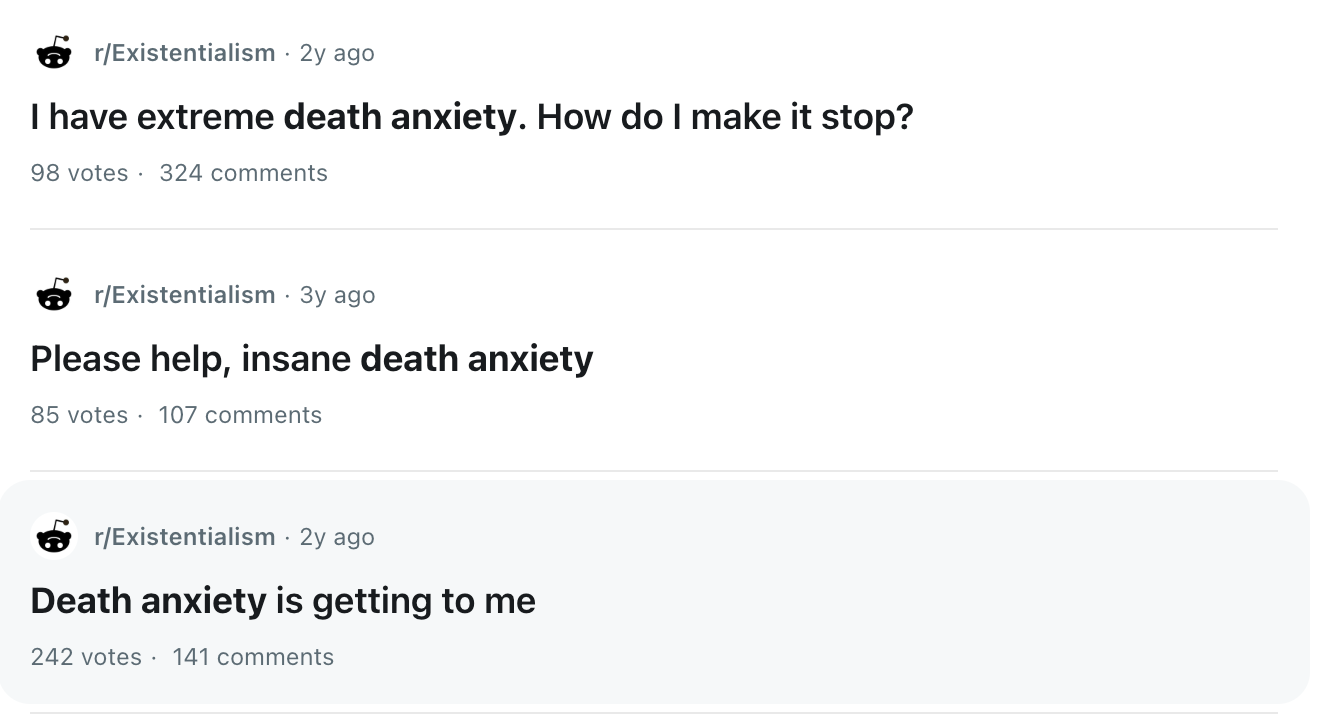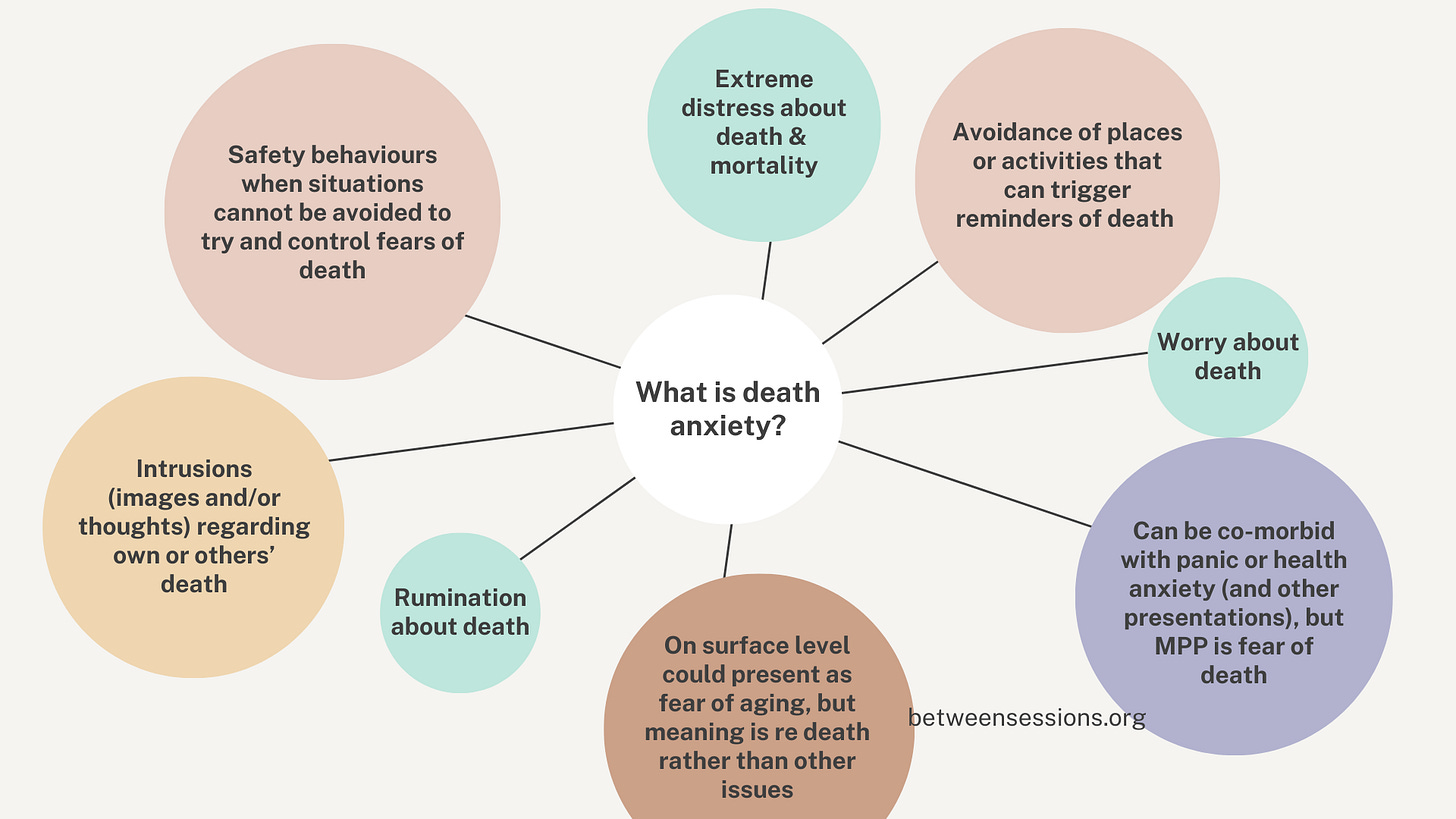Confronting the Fear of Death: An Analysis of Death Anxiety Through the Lens of CBT
The fear of death is a common concern that becomes more than a passing thought, how can CBT help confront the fear and anxiety of the inevitable?
Fast Facts
Up to 16% of people experience death anxiety, with 3% reporting intense fear
CBT effectively reduces death anxiety through exposure therapy and thought reframing. Read to find out how.
Online CBT programs offer promising, cost-effective treatment options
Cultural sensitivity improves treatment outcomes
Death anxiety, the persistent fear over one’s death or the death of others, presents a challenge for CBT practitioners. The fear can interfere with daily functioning and therapists may face difficulties in identifying the most effective strategy to address these anxieties.
Death anxiety is particularly relevant, with increased exposure to mortality-related events and the growing recognition of death anxiety as a mental health concern.
But, is CBT an effective intervention for reducing death anxiety?
What makes Death Anxiety different?
Death anxiety refers to the fear or unease individuals may experience when contemplating death. Research has found that up to 16% of people experience death anxiety and 3% reported intense fear of death.
Having a fear of death is normal, but some levels of death anxiety can be excessive and a persistent fear can contribute to mental health issues such as health anxiety, depression, and panic disorders. Certainly, many clients underlying meaning to fears in health anxiety and panic disorder, can often be related to the fear of death.
As the recognition of death anxiety as a distinct issue arises, the need to address these fears through evidence-based treatments become increasingly imperative.
Can CBT be effective in reducing Death Anxiety?
CBT has demonstrated efficacy in treating death anxiety. Techniques such as exposure therapy have been found useful in reducing fears of death1.
Examples:
· Imagining the death of a loved one or one’s own death
· Watching films and reading books about death
“Meta-analysis found that exposure therapy is most effective at reducing fears of death. These approaches can be effective to normalise death and become accepting of it” says Rachel Menzies, a Clinical Psychologist, when answering Q&A on death anxiety for psychwire.
New research has shown some cost-effective approaches that are also effective.
An online CBT intervention called Overcome Death Anxiety (ODA) by Menzies et al.2, has been found to reduce death anxiety in a clinical sample. The study includes participants with different anxiety related disorders such as anxiety and obsessive-compulsive disorder.
The ODA course includes seven CBT-based treatment modules which participants complete online.
After the CBT intervention, death anxiety decreased significantly in the intervention group compared to the control group.
How so?
CBT was efficient in reducing death anxiety in patients suffering from heart failure by helping them avoid catastrophic thoughts about the disease and replace them with positive ones3.
Interestingly, many CBT therapists may think to classify this as health anxiety, rather than death anxiety, speaking to the nuances of diagnosis and appropriate treatment.
A 2022 also study highlighted significant reductions in death anxiety using spiritual care-based approaches which focus on listening to the patient and building interpersonal communication skills such as trust and honesty4.
Clinicians are increasingly adopting traditional CBT frameworks to address the unique challenges associated with death anxiety, underlining its flexibility and applicability.
Key Considerations
The main approaches used within CBT are:
Exposure therapy: The gradual exposure to things you fear around death
Reframing thoughts: Identifying and alternating thoughts that are negative
Spirituality: Utilising spiritual or religious beliefs where you can rely on and believe in a deity5
But despite its benefits, treating death anxiety presents several challenges.
Such as:
Client resistance: Some clients may be resistant to confront their fears
Cultural and religious beliefs: These beliefs can influence a client’s experience of death anxiety
Relapse: Clients may experience increased symptoms even after making progress6
Clinical fears: Clinicians may feel uncomfortable at the distressing nature of exposure tasks and fear of distressing clients further
While CBT remains a primary choice, other therapeutic modalities, such as Acceptance and Commitment Therapy (ACT) and existential therapy, offer alternative frameworks for addressing fears of death.
Adopting a culturally competent approach, integrating clients’ values and beliefs into the therapeutic process can help clients from all different backgrounds.
Clinical Applications
How can therapists address these issues?
Utilising a range of evidence-based techniques such as cognitive restructuring and exposure.
A cultural or religious approach to help clients who struggle and may feel marginalised due to their cultural or religious beliefs.
Maintaining open communication and regularly monitoring progress can mitigate challenges involving treatment avoidance and emotional distress during exposure exercises.
Prepping in supervision and discussing fears of client distress during exposure.
Moving Forward
Interventions such as CBT offer a robust framework for addressing death anxiety and are bringing attention to this lesser spoken-about, but present, difficulty.
What do you think? What strategies have you found to be most effective in treating death anxiety within your practice? How can we continue to improve therapeutic approaches to this issue?
Author: Muhammod Yeahia
https://psychwire.com/free-resources/q-and-a/14jh44x/death-anxiety
Menzies, R. E., Coutts-Bain, D., Richmond, B., & Helgadottir, F. D. (2025). Protocol for a randomised controlled trial of Overcome Death Anxiety: an online cognitive behavioural therapy intervention in a clinical sample. Behavioural and Cognitive Psychotherapy, 1–9. https://doi.org/10.1017/s1352465824000493
Moradi, M., Akbari, M., & Alavi, M. (2022). The effect of cognitive‐behavioral therapy on death anxiety and depression in patients with heart failure: A quasi‐experimental study. Perspectives in Psychiatric Care, 58(4), 2791–2799. https://doi.org/10.1111/ppc.13125
Gulbahar Eren, M., Üçgül, K., & Sert, H. (2023). Effectiveness of Interventions on Death Anxiety and Fear in Adults with Chronic Disease: A Systematic Review and Meta-Analysis of Randomized Controlled Trials. OMEGA - Journal of Death and Dying, 0(0). https://doi.org/10.1177/00302228231167725
Hosseini, S. M., Naseri-Salahshour, V., Farsi, Z., Esmaeili, M., Sajadi, M., Maddah, Z., & Fournier, A. (2022). The effect of spirituality-oriented psychological counseling on the fear of death among patients undergoing chronic hemodialysis: A randomized controlled trial. European Journal of Integrative Medicine, 49, 102103. https://doi.org/10.1016/j.eujim.2022.102103
Furer, P., & Walker, J. R. (2008). Death Anxiety: A Cognitive-Behavioral Approach. Journal of Cognitive Psychotherapy, 22(2), 167–182. https://doi.org/10.1891/0889-8391.22.2.167



